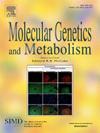Substrate reduction using a glucosamine analogue in Drosophila melanogaster and mouse models of Sanfilippo syndrome
IF 3.5
2区 生物学
Q2 ENDOCRINOLOGY & METABOLISM
引用次数: 0
Abstract
Mucopolysaccharidosis (MPS) types III A and C are inherited neurodegenerative disorders resulting from the lack of a specific enzyme involved in heparan sulfate (HS) catabolism, leading to the accumulation of partially-degraded HS fragments. At present, there are no approved treatments and death is commonly in the second decade of life. Several therapies have undergone pre-clinical evaluation for these conditions, including substrate reduction therapy, with the most studied compound of this class being the isoflavone genistein. However, findings from a Phase III clinical trial demonstrated that high dose oral genistein did not significantly improve neurodevelopmental outcomes in patients with MPS III (Sanfilippo syndrome). Here, we have tested an N-acetylglucosamine analogue, 4-deoxy-N-acetylglucosamine peracetate, as a novel substrate reduction therapy for HS-storing lysosomal storage disorders such as MPS III. Treatment with this compound significantly reduced HS levels in cultured MPS IIIA patient and mouse fibroblasts in a time- and dose-dependent manner. MPS IIIC Drosophila fed 4-deoxy-N-acetylglucosamine peracetate contained significantly less HS relative to those raised on control diets. Likewise, improvements in HS load within the MPS IIIA mouse brain suggests that the compound crossed the blood-brain barrier after oral administration. Although long-term studies are needed, these findings indicate that 4-deoxy-GlcNAc peracetate may be beneficial in slowing the accumulation of HS and may represent a novel substrate reduction therapeutic for MPS III and potentially other HS-storing disorders.

在黑腹果蝇和圣菲利波综合征小鼠模型中使用葡萄糖胺类似物减少底物
粘多糖病(MPS) III型A和C型是一种遗传性神经退行性疾病,由于缺乏参与硫酸肝素(HS)分解代谢的特定酶,导致部分降解HS片段的积累。目前,尚无批准的治疗方法,死亡通常发生在生命的第二个十年。针对这些疾病的几种疗法已经进行了临床前评估,包括底物还原疗法,这类化合物中研究最多的是异黄酮染料木素。然而,一项III期临床试验的结果表明,大剂量口服染料木黄酮并没有显著改善MPS III (Sanfilippo综合征)患者的神经发育结局。在这里,我们测试了一种n -乙酰氨基葡萄糖胺类似物,4-脱氧- n -乙酰氨基过乙酸葡萄糖胺,作为一种新的底物还原疗法,用于治疗hs储存溶酶体储存疾病,如MPS III。该化合物以时间和剂量依赖的方式显著降低培养的MPS IIIA患者和小鼠成纤维细胞中的HS水平。喂食4-脱氧- n -乙酰氨基过乙酸葡萄糖胺的果蝇体内HS含量显著低于对照组。同样,MPS IIIA小鼠脑内HS负荷的改善表明,口服给药后,该化合物穿过血脑屏障。虽然需要长期研究,但这些发现表明,4-脱氧-过乙酸glcnac可能有利于减缓HS的积累,并可能代表一种新的底物还原治疗MPS III和潜在的其他HS储存疾病。
本文章由计算机程序翻译,如有差异,请以英文原文为准。
求助全文
约1分钟内获得全文
求助全文
来源期刊

Molecular genetics and metabolism
生物-生化与分子生物学
CiteScore
5.90
自引率
7.90%
发文量
621
审稿时长
34 days
期刊介绍:
Molecular Genetics and Metabolism contributes to the understanding of the metabolic and molecular basis of disease. This peer reviewed journal publishes articles describing investigations that use the tools of biochemical genetics and molecular genetics for studies of normal and disease states in humans and animal models.
 求助内容:
求助内容: 应助结果提醒方式:
应助结果提醒方式:


